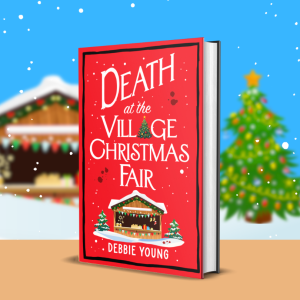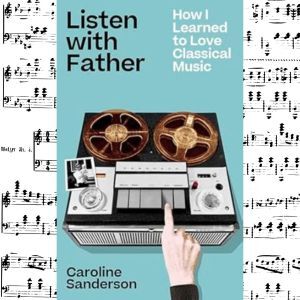Debbie Young's Blog
September 22, 2025
Bear With Me
This week, another post about an aspect of my writing life, as featured in the September issue of the Tetbury Advertiser.
Tidying my study after the summer holidays, I declutter my desk, taking it down to bare essentials. There’s a pen tray and bottle of ink, a pencil pot, a shelf of project notebooks, and a stack of four in-trays, one tray for each area of my working-from-home life. This orderly setup makes me feel in control when other evidence points to the contrary.
More important, though, are four tiny talismans. Not otherwise superstitious, I regard these talismans as essential tools of my trade.
A small piece of the Berlin Wall reminds me that no problem is insurmountable. And yes, the concrete fragment is genuine. I bought it from an official Berlin Wall merchandise shop in the heart of the reunified city.
 Guaranteed genuine fragment
Guaranteed genuine fragmentA multifaceted plastic diamond, a gift from my daughter, helps me focus on what matters. One Christmas, as a small child, in Marks and Spencer she spotted a pack of a dozen of them, sold for a few quid as tree decorations. A keen bargain-hunter from an early age, she was delighted to realise she could afford to give everyone in the family a diamond for Christmas. I’d rather have this plastic diamond given with her love than the real thing without it.
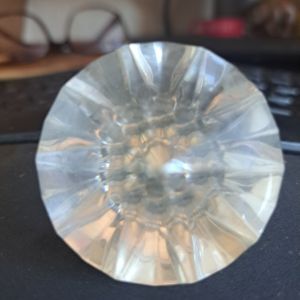 It’s the thought that counts
It’s the thought that countsA more recent gift from her is a small wooden cube she’d painted with the words “writer’s block”. This quip helps me worry less about my workload. Last time I was stressing about meeting a writing deadline, she said to me, “But you always DO get it done, Mum”, and she’s right.
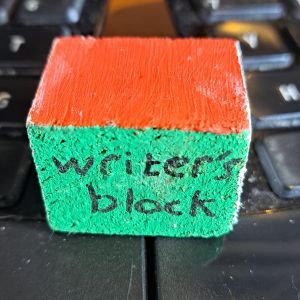 As featured in last week’s post, which was actually about writer’s block
As featured in last week’s post, which was actually about writer’s blockThe fourth desktop mascot is a small wooden bear who fits perfectly into the palm of my hand. It’s a reproduction of a piece of netsuke, the name given to the carved ornamental fasteners used in Edo-era Japan to attach a pouch to a kimono. (Men’s kimonos, unlike the women’s, had no pockets – my pet hate in a garment.)
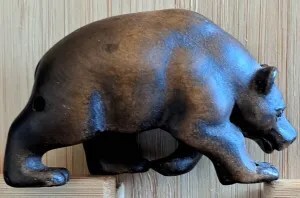 If you look at his tail end, you’ll see a hole that allows him to be sewn onto the scarf.
If you look at his tail end, you’ll see a hole that allows him to be sewn onto the scarf.What’s a wooden bear done to earn a place on my minimalist desk? Well, each mystery in my Cotswold Curiosity Shop series revolves around an object for sale in Alice Carroll’s bric-a-brac emporium. In my new novel, Death at the Village Christmas Fair, a little netsuke bear in her shop is a vital clue to solving a murder at the local Santa Run. With every suspect in the race dressed as Father Christmas, finding the killer is never going to be easy – and Alice needs all the help she can get. Holding the bear in my left palm spurred me on to finish the book while I was puzzling over tricky plot points.
Death at the Village Christmas Fair was published on 16th August, and I’m already halfway through my next novel. But I’ve grown so fond of little Ursa Minor, as I like to call him, that I’m letting him stay on my desk – at least until he’s ready to hibernate.
Available from all good book shops, as a paperback, hardback, ebook, and audiobook. (Quote ISBN 978-1835185827 to order the paperback from your favourite local bookshop.)
IN OTHER NEWSI’m working flat out on editing the manuscript of my next novel, The Importance of Being Murdered, to be published by Boldwood Books early 2026. This is the novelisation of the murder mystery event that I wrote for my village’s amateur dramatics group earlier this year.
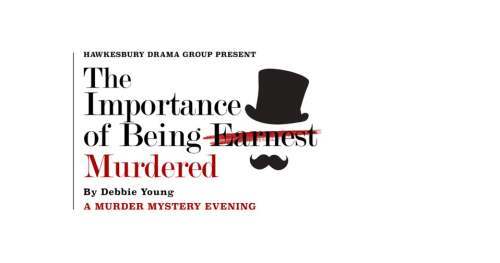
I’m also preparing for my next public event, which is the Hawkesbury Upton Literature Festival‘s tenth birthday event, a day of talks and readings on the theme of Strength of Character. This will take place in the gorgeous setting of our Grade-I listed parish church, St Mary the Virgin, Hawkesbury. Tickets are still available here. If you’re in striking distance of Haweksbury, do come along – it’s going to be great fun! This time it even includes paintings and sculpture, all of which tell stories that match the event’s theme.
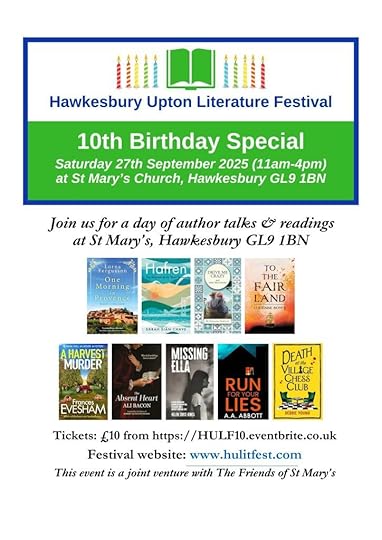 Book your tickets now!WHAT I’M READING THIS WEEK
Book your tickets now!WHAT I’M READING THIS WEEK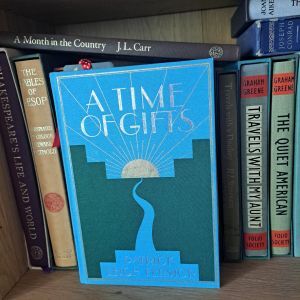 The only book I read last week hasn’t been published yet, as it’s an advance copy of a novel sent to me by the author’s publisher asking for a pre-launch review. I’ll share my review of it when it’s launched.
The only book I read last week hasn’t been published yet, as it’s an advance copy of a novel sent to me by the author’s publisher asking for a pre-launch review. I’ll share my review of it when it’s launched.
Meanwhile I’m nearing the end of part one of Patrick Leigh Fermor‘s travelogue about walking from London to Constantinople in the 1930s, A Time of Gifts. It seems to be taking me almost as long to read as he did to do the walk! But that’s only because he writes dense, rich prose, so I’m reading it in very small chunks and savouring it along the way. Another factor is that I’m reading a huge and beautiful Folio edition hardback, which adds extra pleasure, but is tiring to hold open for very long. I have a feeling that if I were reading a paperback or ebook, I’d be travelling rather faster.
September 15, 2025
How to Overcome Writer’s Block
Writer’s block: it’s a term lots of people bandy around as if it’s some kind of medical or psychological condition that blocks creative flow.
I have strong views about writer’s block, which I shared in my talk the Troubador Publishing‘s annual Self Publishing Conference in Leicester on Saturday. While the talk is still fresh in my mind, I thought I’d share my reasoning in this week’s blog post.
Whether or not you are a writer, I hope you’ll find it interesting, because the same principles apply to other forms of activity.
In short, I don’t believe in writer’s block.
Writing isn’t a skill that flows like water from a tap, turned on and off by some secret force, whether the writer likes it or not.
If you are committed to writing anything – whether fiction, non-fiction, poetry, journalism or journals – you will always be able to write, unless you are unfortunate enough to develop a medical crisis that damages the relevant part of the brain.
This happened to journalist Robert McCrum, who had a devastating stroke at the age of 42 radically affecting his wordpower. McCrum’s moving memoir, My Year Off, tells the story of his remarkable recovery.
Of course, not all stroke victims are as lucky as Robert McCrum. But my point is, blaming writer’s block for stopping you writing is a self-inflicted construct, not a medical condition.
What Really Causes Writers to Stop Writing?In my view, there are three main reasons:
trying to write a story before it’s readystarting a story in the wrong placeattempting to write the wrong thingBy story, I mean any piece of creative writing, from a school essay to a company report, from a poem to a novel.
There are simple solutions to each one:
Allow your story more time to brew. Maybe you need to allow the elements that inspired and informed your planned piece to stew for a little longer in your subconscious first. You might also try conscious planning, whether or not you usually plan what you write – and plenty of successful authors are self-professed “discovery writers” or “pantsers” who literally make up the story as they go along. (Lee Child is the most famous of these, starting each book on 1st September each year with a single sentence, and no idea of where the story would take him.) Personally, I plan each novel in outline form, form before I start writing – but only when my story has percolated enough to be planned.
Write yourself into the story – then edit out the surplus. It’s quite common for the first chapter or two of a draft novel to be cut in the editing process, because it’s not necessary to the finished work – the writer just used it to warm up. Don’t assume your first draft must be perfect – just get the basic story down, and polish it afterwards. You can’t polish a blank piece of paper. “The cat sat on the mat” is the writing prompt suggested by Cassandra Mortmain to her father, a famous author paralysed by writer’s block, in Dodie Smith’s captivating debut novel, I Capture the Castle (one of my favourite books of all time, and a must-read for aspiring writers) – with astounding results.
“Write anything—write ‘The cat sat on the mat‘ if you like. Anything, as long as you write!” – Dodie Smith in ‘I Capture the Castle’: Part 3, Chapter 15
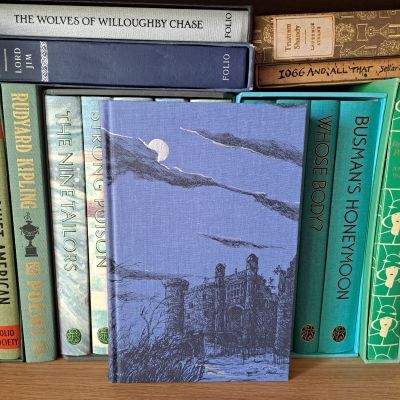 The beautiful hardback Folio edition of “I Capture the Castle”, a recent treat to self as my much-read paperback edition is too fragile to reread
The beautiful hardback Folio edition of “I Capture the Castle”, a recent treat to self as my much-read paperback edition is too fragile to rereadDitch the project that you’re having trouble with – or at least set it to one side for later – and ask yourself what you would prefer to be writing. Does your heart lie elsewhere? Should the memoir you’re struggling flow better if you treated it as a novel? Is what you thought was going to be a cosy mystery really meant to be a psychological thriller? Remain open-minded about what sort of writer you are. It was my pleasure to meet at Saturday’s conference a Professor of International Business and Corporate Governance used to writing academic papers who had realised he needed to write a novel. The Land Remembers, by Amon Chizema, will be launched in November. (More about Professor Chizema here.)
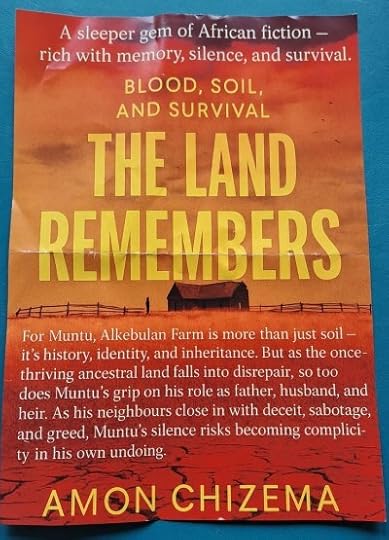 The flyer for his book that Professor Chizema gave me on Saturday – to be published by Troubador on 28th November, and now available to pre-order
The flyer for his book that Professor Chizema gave me on Saturday – to be published by Troubador on 28th November, and now available to pre-orderAlternatively, if your project has been flowing well until you ground to a halt, leave a blank and go on to write the next passage after the tricky one. When you come back to fill in the blank, you’ll most likely find it flows effortlessly.
I reckon the same thinking applies to other fields of life, eg I might like to think I have housework block, but that doesn’t make me any less able to pick up a duster.
I have plenty of other ideas for re-igniting stuck writing, but I’ll save those for another post.
In the meantime, do you have any views on writer’s block? I’d love to hear them – please leave a comment below. As the late lamented Mrs Merton (aka Caroline Aherne) used to say on her TV show, “Let’s have a heated debate!”
In Other NewsWhile preparing to submit my next novel manuscript to my publisher, I’m also gearing up for the next event of the Hawkesbury Upton Literature Festival, which I founded ten years ago in my home village. The theme this time is “Strength of Character“, and there’s a cracking line-up for day of author talks, readings and discussions, on Saturday 27th September. If you’re within striking distance of St Mary’s, Hawkebury (GL9 1BN), I’d love to welcome you to the event! Find out more and book your tickets at the HULF website, www.hulitfest.com, or via Eventbrite at HULF10.eventbrite.co.uk.

What I Read Last Week
 Scoop by Evelyn Waugh
Scoop by Evelyn Waugh
I’ve read the paperback of this hilarious dark comedy of mistaken identity of a hapless nature notes journalist many times, so it was a natural choice for my next audiobook listen after enjoying Waught’s Brideshead Revisited” on Audible.
Simon Cadell’s narration is wonderful, effortlessly switching between characters, social strata, and nationalities as the story flits from London high society to rural Somerset to a fictitious, warring country in Africa. I enjoyed his acting so much that I searched in vain for more audiobooks he’d recorded – sadly he died long before audiobooks in their modern form became a thing.
Although some of the language and attitudes wouldn’t pass muster in 21st-century publishing, if you’re able to allow for the book being the product of its era, you can pass those by without it spoiling the story. Very much of the satirical humour still applies to modern society, including to journalism and publishing.
A fun read that helped pass the time agreeably as I prepared mountains of apples from our garden, ready for the freezer.
 The Durrells of Corfu
by Michael Haag
The Durrells of Corfu
by Michael Haag
Spotting this book in a charity shop, I couldn’t resist it, as I’ve been a fan of Gerald Durrell since reading “The Bafut Beagles” in my English class in my first year of secondary school.
I’ve read many of his books, and also one by his sister Margo, and his brother Lawrence’s memoir of Corfu, so was interested to come across one by a third party profiling the whole family.
Haag’s biography starts with the family’s early days in India and ends with the success of Gerald’s conservation-led zoo in Jersey, and it addresses some of the unanswered questions sidestepped by the various family members, eg more details of his parents relationship and his mother’s issues following widowhood. It’s respectful and informative, so should not upset Durrell fans, including those who have only discovered him lately due to the enormously popular TV series set on Corfu.
Definitely worth a read for any fans of any of the Durrells, with the bonus of plenty of old family photographs, which have never to my knowledge been shared in any of the family’s books.
(All book links are Amazon Affiliate links, which means I earn a tiny amount for any copies sold when you click through to them)
September 10, 2025
Two Weddings and a Victory
Living in a small Cotswold village with a lively community provides ideas and inspiration for writing my cosy mystery novels. I’ve served on many committees, belonged to different organisations, and taken part in lots of activities since I moved here over thirty years ago.
One of my favourite activities here is ringing the church bells, which were installed in our parish church of St Mary the Virgin, Hawkesbury in 2021. As I soon discovered, in the English tradition of circle-mounted church bells, there’s much more to church bell-ringing than one might think. Full-circle ringing is not just a question of pulling the end of a rope at random.
I soon became hooked, and I’m now evangelical about this ancient craft. In my column for the September issue of the Hawkesbury Parish News, written during a month with a busy ringing schedule, I wrote the following piece to encourage others.
Writing this column in between two weddings and VJ80 Day, all three of which events involved bell ringing at our parish church, I’d like to share some of the surprising benefits of being a bell ringer. You never know, my revelations might persuade you to give it a try yourself.
1. Exercise
The slow, steady pulling of the bell rope (sally) against the resistance of a bell’s weight provides a gentle but significant workout in manageable bursts. Time and again, ringers arrive at the tower saying, ‘Not sure I can ring tonight, I’ve put my back out’ – only to skip down the tower stairs afterwards, fully restored.
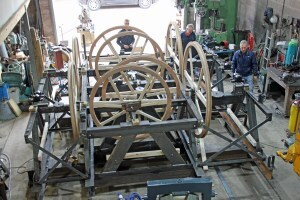 The complex framework that holds bells for full-circle ringing, pictured in Matthew Higby’s workshop before installation at St Mary’s (Photo by Sir Ian Macfadyen)
The complex framework that holds bells for full-circle ringing, pictured in Matthew Higby’s workshop before installation at St Mary’s (Photo by Sir Ian Macfadyen)2. Teamwork
While each person is responsible for only one bell, we work as a band led by a conductor, just like any other group of musicians – only our instruments are bigger than everyone else’s.
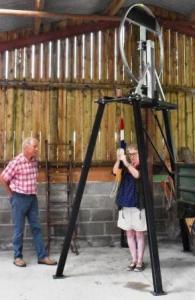 Learning the basics of bell ringing on the dumb bell, under the guidance of St Mary’s Tower Master Colin Dixon
Learning the basics of bell ringing on the dumb bell, under the guidance of St Mary’s Tower Master Colin Dixon
3. Belonging
The mental health benefits of feeling part of a community are well known. Bell ringing creates a great sense of camaraderie, not only in one’s home tower, but at other churches. Travelling beyond the parish, bell ringers are assured of a warm welcome in any other tower.
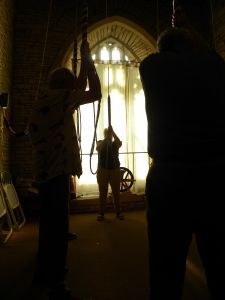 Photo by Anne Bishop, a Canadian visitor who tried her hand at ringing
Photo by Anne Bishop, a Canadian visitor who tried her hand at ringing4. The Best View
Because we ring in an open-sided chamber rather than on an enclosed platform, we have the best view in the house. It’s especially enjoyable at weddings, watching from above as the bridal party processes.
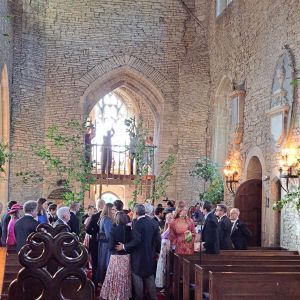 The ringing chamber viewed from the nave of St Mary the Virgin Hawkesbury
The ringing chamber viewed from the nave of St Mary the Virgin Hawkesbury
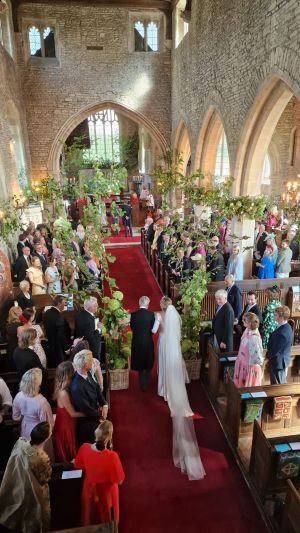 … and the view of a wedding from the bell ringing platform
… and the view of a wedding from the bell ringing platform5. Historical Role
We play a part in history, not only on a local level at parishioners’ christenings, weddings and funerals, although that’s also an honour. It has been a memorable privilege to ring to mark the death of Queen Elizabeth, the proclamation of the King, his coronation, VE80 and VJ80. It’s especially exciting when we know we’re ringing simultaneously with ringers nationwide, even though we can neither hear nor see them.
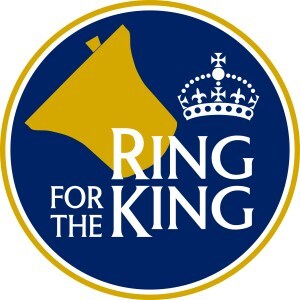 It was an honour to be part of the national programme of rinigng for the coronation of Charles III
It was an honour to be part of the national programme of rinigng for the coronation of Charles III6. Tradition
We’re keeping an ancient craft alive. I learned to ring to honour the memory of my great-grandfather, a distinguished ringer of complex peals of 12 bells long before I was born. I may never be able to ring to his standard, but that feeling of following in his footsteps and passing ringing on to future generations is priceless.
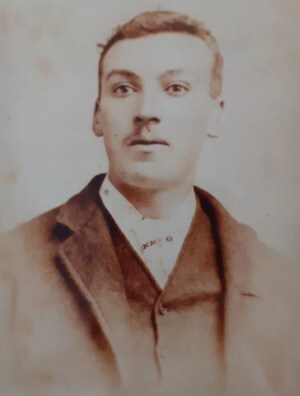 My great grandfather, an accomplished bell ringer
My great grandfather, an accomplished bell ringerNew bell ringers are always welcome at St Mary’s. No experience is necessary, and free training will be given. Most ringers aren’t religious, and you won’t be expected to stay for church services or to commit to specific ringing events. So if you fancy trying your hand at bell ringing this autumn, contact Colin Dixon, St Mary’s Tower Captain, or join us at St Mary’s at practice nights, 6.30-8pm every Wednesday. All ages welcome – you just need to be tall enough to reach the ropes.
PS Just thought of bonus point 7 – as the nights draw in and temperatures dip, it’s worth knowing that ringing church bells will warm you up in winter!
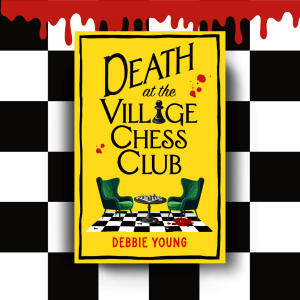 …in which the mystery is resolved in the bell tower of the parish church in Little Pride
…in which the mystery is resolved in the bell tower of the parish church in Little PrideIf you’d rather read about bell ringing than ring in real life, try my cosy mystery novel, Death at the Village Chess Club, where the denouement takes place at the bell tower!
PPS Our parish church of St Mary the Virgin, Hawkesbury, will be the setting for the next Hawkesbury Upton Literature Festival event on Saturday 27th September, with a fabulous day of talks, readings and panel discussions on the theme of “Strength of Character“. For more information and to book your tickets now, visit hulitfest.com. I’d love to see you there!
 Book your tickets now!What I Read This Week
Book your tickets now!What I Read This Week Brideshead Revisited: The Sacred and Profane Memories of Captain Charles Ryder by Evelyn Waugh
Brideshead Revisited: The Sacred and Profane Memories of Captain Charles Ryder by Evelyn Waugh
Usually, I prefer to read the original book before watching a film or TV series of it, but in the case of Evelyn Waugh’s heartrending Brideshead Revisited, I first experienced it as the very faithful BBC TV dramatisation in the 1980s, starring Jeremy Irons as the narrator, Charles Flyte. Waugh has since become one of my favourite authors, and I’ve read many of his books many times.
Needing something soothing to listen to in the car on long journeys, I downloaded the Audible edition of Brideshead Revisited, narrated by Jeremy irons. It’s a flawless rendition, with Irons rendering the voices of the many characters, male and female, with a multitude of accents.
I was instantly transported into the heady world of the book, and long drives flew by – even though I’m not usually very good at listening to fiction on audio, able to concentrate better on non-fiction.
This audiobook was a hard act to follow, but I’m now revisiting another Waugh favourite, the darkly comic novel Scoop, narrated equally brilliantly by Simon Cadell.
September 1, 2025
The Secret Life of Button Boxes: Memories, Mysteries, and a Murder Clue
When, as a child, I used to play with my grandma’s button box, I admired each button like a tiny work of art.
Born in 1900, Grandma grew up fastening her button-boots with buttonhooks. As a young woman, she embraced flapper styles. The contents of her tin gave a miniature history of twentieth-century fashion.
My mum (91) still has her own button box from when she used to make clothes for her children. Her 21st birthday present was a hand-cranked Singer sewing machine, on which I later learned to sew.
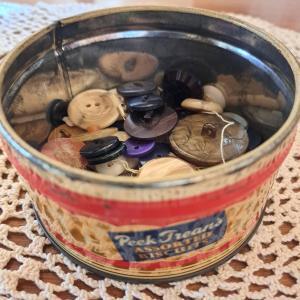 My mum’s button box
My mum’s button boxMy grandma and my mum used old toffee and biscuit tins as button boxes. But my buttons live in a smart Cath Kidston tin, labelled The Book of Buttons.
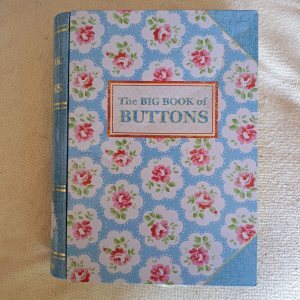
My daughter uses a tartan shortbread tin to house hers.
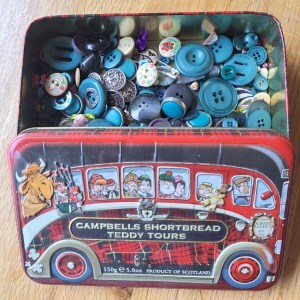
Whose duffle coat did this toggle once fasten?Which child fiddled with this little blue one on their school cardigan during a tedious lesson?What kind of party dress did this diamante disc once adorn?The contents of every button box are unique. Plunging your hand in is like a lucky dip. You never know which tiny treasure you’ll pull out, nor its provenance.
Last century, every home had a button box. These days, with fewer people making their own clothes, it’s an endangered species. Yet it’s easy to keep the tradition alive. You can buy interesting vintage buttons in any charity shop or thrift store. If you’re lucky, you’ll find something similar to the fancy fastener at the heart of the mystery in my new novel, Death at the Village Christmas Fair.
When Wendy chooses a bear-shaped button from her daughter Alice’s Cotswold Curiosity Shop and sews it onto a hand-knitted scarf, it soon becomes a vital clue in the hunt for a ruthless killer.
 If you look at his tail end, you’ll see a hole that allows him to be sewn onto the scarf.
If you look at his tail end, you’ll see a hole that allows him to be sewn onto the scarf.The unusual scene of the crime is a Santa Run, in which hundreds of fun-runners race dressed as Father Christmas. What’s so special about Wendy’s little wooden bear? You’ll have to read my novel to find out!
Do you have a button box in your home? What’s your most unusual button? Which is your favourite, and why?
Death at the Village Christmas Fair is now available in ebook, paperback, hardback and audiobook. The third in the Cotswold Curiosity Shop cosy mystery series, it may also be read as a standalone novel.
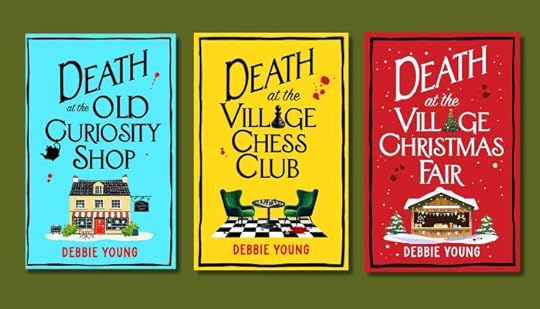 All three books in the series so far can be read as stand-alone novels, but it’s best to read them in order
All three books in the series so far can be read as stand-alone novels, but it’s best to read them in order(This post first appeared on the blog of Boldwood Books, my publisher.)
In Other News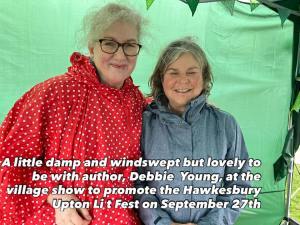 Thanks to Sarah Chave for the photo. We didn’t let rain stop play!
Thanks to Sarah Chave for the photo. We didn’t let rain stop play!I’m just recovering after a very wet and windy Hawkesbury Show, where our Hawkesbury Upton Literature Festival tent nearly blew away. I’m sure we had the most windswept spot on the showground – the wind seemed to be coming from all directions at once! However, I had great fun with fellow authors Lucienne Boyce, Sarah Siân Chave, Frances Evesham and Jack (Jackie) Chandler. All except Jackie will be speaking at the next Festival event on Saturday 27th September – and the only reason Jackie’s not coming is that she lives in Germany, otherwise she’d be there like a shot! Thanks to Sarah for the attached photo of us on the stand, dressed for the weather!
I’d just about dried out and warmed up in time to give a short talk at the traditional annual Songs of Praise service held in the Show Marquee next morning (thankfully in sunshine by Sunday morning!) At our Songs of Praise service, six local residents are invited to choose their favourite hymns and tell us why they’ve chosen them. It’s always fascinating to learn more about well-known hymns and heartwarming to learn about the personal connections for the speakers. For this service, I spoke about the power of music to unite communities and bring people to faith.
As a Lay Worship Leader, I occasionally give short talks at services. Lay Worship Leaders aren’t licensed to preach – instead we just talk about something timely or relevant for each service. I thinking of saving them up to turn them into a small book, similar to my collected columns for the Tetbury Advertiser and Hawkesbury Parish News. Let me know if that’s something you’d like to read.
Now that the Show is over, I can concentrate on preparing for the Hawkesbury Upton Literature Festival on Saturday 27th September, which will take “Strength of Character” as its theme. The programme is going to be fascinating. Find out more and book your tickets here.
And with my other hand, I’m still writing my novelisation of The Importance of Being Murdered, due to launch early 2026.
But somehow, I still find time to curl up with a book….
What I Read Last Week Hafren: The Wisdom of the River Severn by Sarah Siân Chave
Hafren: The Wisdom of the River Severn by Sarah Siân Chave
A fascinating personal response to the Hafren, aka the River Severn, with something for everyone.
Following the course of the river from its source just outside Aberystwyth, Sarah Chave’s narrative Includes Welsh mythology and Welsh and English social history, as well as geography and natural history, environmentalism, and family history.
Overall it is a thoughtful, philosophical work, acknowledging and mourning the impact of industrialization and climate change, but also an effective cry for positive action going forward. While nostalgic for what we have lost, it is ultimately constructive, as evidenced by the following quote:
Pastoralism can provoke feelings of nostalgia, a yearning for an unchanging utopian idyll, but it can, instead, be a approached in a different way – as a challenge to care for and protect the wider natural world.
The author cites and embraces Rupert Reed’s argument in favour of “thrutopias” to “encourage us to live our dreams in the present where we can, change things where we cannot, and strive together towards building a more caring world for all”.
Illustrated with a route map of the river to give the reader their bearings, and gentle black and white drawings by Rachel Elinor Collis, the book also boasts an evocative, slightly dream-like cover illustration by Andy Ward. All in all it’s a slick and beautiful package, published by the University of Wales’ imprint, Calon Books, which gives it the stamp of authority.
A great gift for anyone who loves any part of the Hafren/Severn, whether Welsh or English – there’s something in there to satisfy all kinds of readers.
 All At Sea by Flora McGowan
All At Sea by Flora McGowan
I downloaded this short story onto my Kindle after having a fun conversationon my Facebook author page about who we name our characters after. She named her central character Carrie after her grandmother. I’ve never yet named one of mine after my beloved grandmothers, Lily and Peggy, but I’m going to think about doing that now.
All at Sea is a gentle tale of a very English day out at the seaside – an outing that sounds as if it should be simple and fun, but in Flora McGowan’s hands, turns into a thoughtful, poignant, memorable and melancholy tale of love, loss and responsibility. I won’t say more for fear of spoiling the plot.
August 25, 2025
In Conversation with Clare Flynn, Author of “The Star of Ceylon”
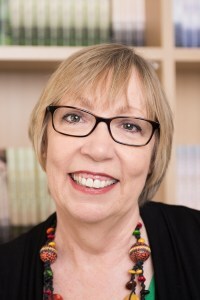 Meet Clare Flynn, award-winning historical novelist
Meet Clare Flynn, award-winning historical novelistI love reading books set in distant countries that I’m unlikely to visit – whether the action takes place in the present day or back in time. Even better when those books have been written by authors who have spent time in those countries for added authenticity and a stronger sense of place. So I was eager to read my avid traveller friend Clare Flynn’s latest historical novel, The Star of Ceylon – which, as you’ll guess from its name, is set in the past, as are all 19 of her historical novels. (Ceylon is the old name for modern Sri Lanka.)
Debbie: Clare, welcome back to my blog, and thank you for answering all my questions about your latest historical novel.
Set in colonial Ceylon when the British empire was at its height and women’s rights and options were limited, The Star of Ceylon spells out clearly the social injustices in both Britain and Ceylon under patriarchal rule. The central characters, Stella Polegate and Norton Baxter, are repelled by these societies’ attitudes, despite having been raised in a system that glorified patriarchy and colonial suppression. How typical is this disdain among their contemporaries? Would what seems to us their more modern attitudes to empire and women have made them outliers?
Clare: Great question!
To deal with Stella first, she was living at the height of the women’s suffrage movement, so her battle against the patriarchy was not unusual at the time – although by no means universal. Some women were among the fiercest critics of the movement – establishing The Women’s National Anti-Suffrage League.
Indeed, it has always seemed to me a great irony that one of its founders was Gertrude Bell – who studied at Oxford, explored the Middle East on a camel, was instrumental in the creation of what became Iraq, was the only woman invited by Churchill to attend the 1921 Cairo Conference, and was the founder of the Baghdad Museum (heavily looted in the Iraq War when US troops failed to protect it).
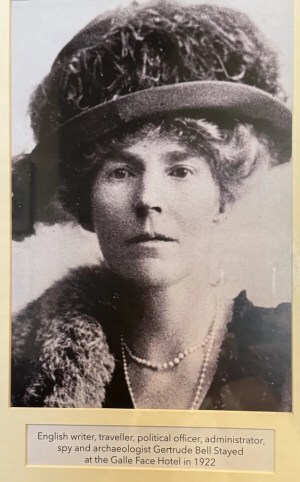 Gertrude Bell
Gertrude BellI suspect her opposition to women getting the vote was based more on a belief that emancipation wasn’t necessary as women like her proved. There were many other distinguished women academics in the Edwardian era – all high achievers but all, like Stella and Bell, denied degrees. I wrote this guest post on this subject for Lorna Fergusson – and since then keep discovering other brilliant, gifted women, denied a platform by the patriarchy.
As for Norton, yes, I believe he was unusual for his time. Most Britons – and certainly most colonial civil servants – would have taken the hegemony of the British Empire for granted. There were exceptions, and one notable one was my inspiration for Norton – Leonard Woolf. His career was in Ceylon – based first in Jaffna, then in Kandy and finally down in the Southern Province in Hambantota. His autobiography, Growing, covers the seven years he spent there. Like Norton, he loved the job but questioned what was behind it. On his first long home leave, he couldn’t face returning and devoting the rest of his life to supporting the empire. He’d fallen in love with Virginia and went into publishing instead, and the couple founded The Hogarth Press.
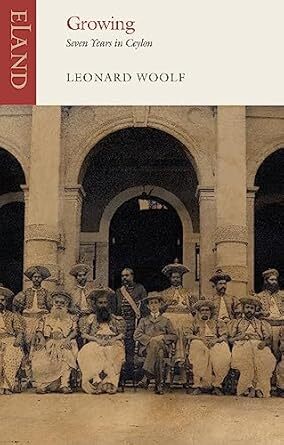 The sequel to “Sowing”, his childhood memoir
The sequel to “Sowing”, his childhood memoir
Debbie: I really enjoyed Woolf’s memoir of his earlier years, Sowing. I’ll have to add Growing to me to-read list!
You spell out dramatically many of what to 21st-century readers must seem shameful features of colonial rule. But what, if any, positive improvements and advantages did imperial powers bring to Sri Lanka?
Clare: It was the British who introduced the tea trade – after a first failed attempt with coffee.
Ceylon rapidly became a byword for the best tea in the world, and it was, and still is, a major source of export revenue – today worth $1.3 billion in foreign exchange to Sri Lanka.
As is often the case in former British colonies, the British built railways – or, more accurately, designed and funded them – while the actual construction was done by local workers. The port of Colombo grew dramatically under British rule and became the gateway to Southeast Asia for Europe, Africa and others. Since then, it has expanded further and remains a significant strategic shipping hub and container port. They also brought the English language with them – still used in administrative matters and as a bridge language between the two official languages, Sinhala and Tamil.
It’s also worth noting that prior to British rule, Ceylon was occupied by the Portuguese and then the Dutch. Neither did much to develop the country. The Portuguese stuck to the coast, focussing on the spice trade and the conversion of the population to Catholicism. The Dutch also concentrated on the coastline but built up the administration and increased trade through the Dutch East Indies Company.
Debbie: You conducted extensive research to enable you to create a vivid and convincing portrait of colonial life. What kind of research did you do? I think you made a special trip there?
Clare: Yes, I visited the country last year – having been before in the 1990s. I visited tea plantations and places that were relics of the empire, staying in colonial-era hotels and absorbing the atmosphere. I did extensive reading too – this post on my blog details all the methods I used.
Debbie: I really appreciated Sathnam Sanghera’s detailed study of the impact of Empire on Britain, Empireland: How Imperialism Has Shaped Modern Britain, and I am looking forward to reading the sequel, Empireworld: How British Imperialism Has Shaped the World. Which books on British Imperial rule did you find the most enlightening and why? Please feel free to include fiction as well as non-fiction.
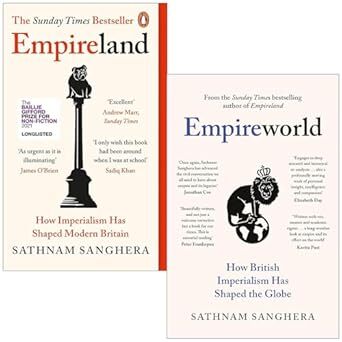 Compelling reading with a 21st-century perspective on the British Empire
Compelling reading with a 21st-century perspective on the British Empire
Clare: I highly recommend Leonard Woolf’s Growing. As well as being a mine of information, it’s a terrific read.
Rather than basing my research on current studies, I prefer to read contemporary accounts so I can see it from the perspective of the kinds of people I’m writing about. I read a dreadful book by Sir Richard Burton – the chap who (wrongly) claimed to have discovered the source of the Nile. He was typical of his times and unshakeable belief in the empire: a blustering, game-hunting, indefatigable imperialist, secure in his conviction of the superiority of the white man.
Another invaluable contemporary source was a gazette of Ceylon in 1906, which detailed the minutiae of the administrative structure of the colony and the people who ran it.
I’m about to do a short course with Oxford University on Britain and its Empire next month – too late for this book, but the British Empire is often the background to my books – particularly the Penang series and Kurinji Flowers. I’ll definitely follow your recommendation and get a copy of Sathnam Sanghera’s Empireland.
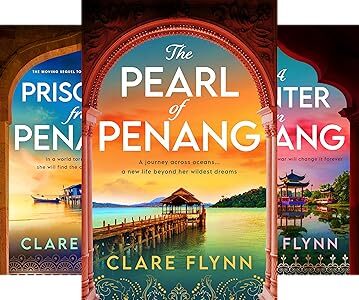 The first three of Clare’s four-book series set in Penang
The first three of Clare’s four-book series set in PenangDebbie: Another important theme in the novel is the inequalities in women’s education back in the UK – while the education of men of a certain class was completely geared to providing administrators of Empire. If women had had equal rights in education, and the vote, while the British Empire was in full swing, would the Empire have turned out any differently?
Clare: What a fascinating question! Oh, Debbie, you’ve sent me down the rabbit hole again. I’ve just found a paper from the LSE entitled “Strengthening the Representation of Women in Diplomacy” which states women ambassadors are still only 20 percent of the total. So, I doubt it would have made much difference as there wouldn’t have been enough of them. Two world wars were the major factor in the end of empire – WW1 sounding the death knell then in WW2, Britain’s humiliation in the Fall of Singapore and the horrendous accumulation of war debt, as well as the rise of independence movements led by Gandhi in India and others elsewhere, making it inevitable and almost immediate.
Debbie: You’ve written many novels set in the early twentieth century. Why does this era so fascinate you, and what can we learn from it today?
Clare: Yes, while most of my books are in the twentieth Century, I’ve set six books – The Green Ribbons, The Gamekeeper’s Wife, the Hearts of Glass trilogy and The Star of Ceylon – between the turn of the century and the early 1920s. I find it such a rich period because it was the zenith of the empire. Going into WW1, the empire was at its greatest size and biggest source of wealth.
The words “the sun never sets on the British Empire” were absolutely true as around twenty percent of the earth was pink on the atlas.
It was a period of high energy and hope, with a flowering of the arts, of ideas, of confidence, reflected in architecture – a walk around central London including Whitehall and Theatreland provides ample evidence of that. The battle for women’s suffrage was at its peak and is always a great inspiration for fiction. The fusty constraints of the Victorian era were being thrown off and there was a tremendous sense of optimism. The world was shrinking because of telecommunications, railways, the internal combustion engine and the beginnings of aircraft.
Of course, as we know – and they didn’t – in the summer of 1914 they were about to be plunged into the horrors of the First World War. That long, hot, glorious summer is extremely poignant, with the images it conjures up of picnics, punting, beautiful floaty dresses, enormous hats, and most of all, of young smartly dressed men bursting with joie de vivre – many of them soon to be dead or disfigured.
What can we learn from it today? Only that we can never know what’s just around the corner. Back then, Britain was the global superpower – richer and more powerful than the United States.
Maybe there’s a message here for the USA – that nothing lasts forever.
Debbie: That’s a heartening thought. Now, as a historical novelist, to what extent are you driven by a desire to entertain and how much are you motivated by the potential of fiction to change modern society?
Clare: My motivation is to entertain. The story always comes first. I want readers to believe in my characters and to be drawn into the story. I don’t think any single book can change society and I don’t aspire to. I try to make people think though – and introduce them to periods of history they may not have been aware of – such as the Malayan Emergency, the Ceylon pearl trade or the WW1 Shell Crisis.
Debbie: You’ve written several trilogies that started out as standalone novels – but on reaching “The End”, you were compelled to continue the story. Will the same happen with The Star of Ceylon? (I’m keen to hear more of Winnie’s story – and of how a certain person is faring in Egypt. No plot spoilers here!)
Clare: Don’t worry – no plot spoilers as I haven’t a clue what happens to them either!
I do feel compelled to finish the story, and I’m discussing a sequel with the publishers. Meanwhile, I’m having a break from Stella and Norton and have just finished writing a completely different book set in Australia during WW2 and follows on from another of my series. That’s all I’m saying!
Debbie: Many novels have been written about colonial India, but you’ve chosen to focus on Ceylon for this story. Why?
Clare: My second novel, Kurinji Flowers is set in colonial India. I chose Ceylon for this book as it’s rarely written about, and I find it a beautiful and interesting country. Sadly, it’s not in the greatest economic shape following the long and bitter civil war, the effects of the global economic crisis and government corruption, so I hope in its small way my book will encourage people to visit it.
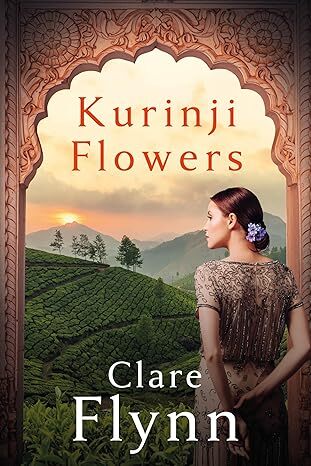 This novel is set in colonial India
This novel is set in colonial IndiaDebbie: Imperial Ceylon couldn’t be more different from twenty-first century Eastbourne where you live and write. Discuss!
Clare: You’d be surprised, Debbie! In the last century Eastbourne was an extremely popular destination for colonial civil servants to retire to – and I’m sure that included Ceylon. The town is full of big rambling Victorian and Edwardian houses. Back in the 1970s, my brother had a job at the local auction rooms and dealt with a plethora of colonial items – elephants’ feet umbrella stands, leopard and tiger skins, intricate inlaid wooden furniture and paintings of game hunts!
Debbie: Where will your travels take you next?
Clare: No book-related trips planned. I’ll probably stick to the British Isles this year. Toying with the idea of Scotland as I’ve only been to Edinburgh and would love to explore the Highlands. Who knows? There could be a book in it – but my aim is a holiday!
Debbie: What, never been to the Scottish Highlands? Clare, you are in for a treat! I’ve travelled very widely in the Highlands with my Scottish husband, so when you start planning that trip, let me know, and I’ll give you a long list of places to inspire you!
Clare: Thank you very much for having me on the blog, Debbie, and for asking such exvcellent questions!
Debbie: You’re very welcome, Clare, and best of luck with book 20 and beyond!
To find out more about Clare Flynn, visit her webiste, www.clareflynn.co.uk, where you can also download a free ebook of short historical fiction stories, A Fine Pair of Shoes , when you join her mailing list.
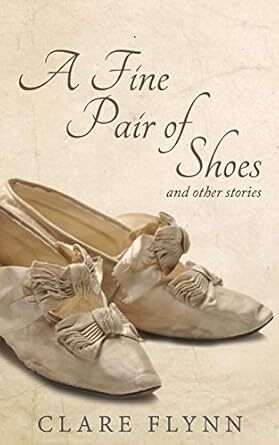 Join Clare’s mailing list to receive this free ebookIN OTHER NEWS
Join Clare’s mailing list to receive this free ebookIN OTHER NEWSI’ve just returned from a lovely stay in Norfolk, where my daughter and I stayed with another author friend, Rory Marsden, who has also been a guest on my blog here. With his own passion for history, Rory was the perfect host to show us the historic city of Norwich and its environs, from its glorious Normal cathedral and castle to tiny parish churches in the middle of flat fields, each with remarkable features. We took a steam train ride from Holt to the seaside resort of Sheringham, where we watched Red Arrows practising their amazing manoeuvres over The Wash, and a boat trip along the famous Broads.
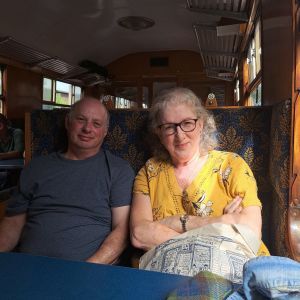 All aboard the Holt to Sheringhma steam train – with our host Rory
All aboard the Holt to Sheringhma steam train – with our host Rory
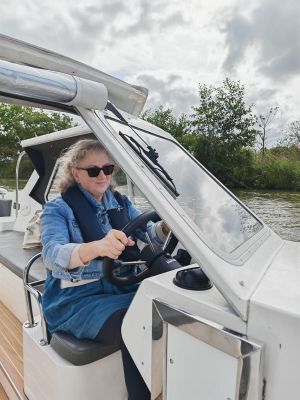 My first time driving a boat on the Norfolk Broads
My first time driving a boat on the Norfolk BroadsReturning rested and energised (once I’d recovered from the long drive home, anyway), I’ve been trying to catch up with the launch PR for my latest cosy mystery novel, Death at the Village Christmas Fair, which wa launched a couple of days before we left for Norfolk. Strange as it may seem, publishers like to launch Christmassy books in the summer, to give stockists plenty of time to order them in for the Christmas shopping season. To my surprise, it seems that readers really like reading such books in high summer, because I’ve already gained 99 reviews on Amazon, (I’m watching like a hawk for the 100th – these psychological milestones matter!) with a 4’6* average, and it’s selling really well!
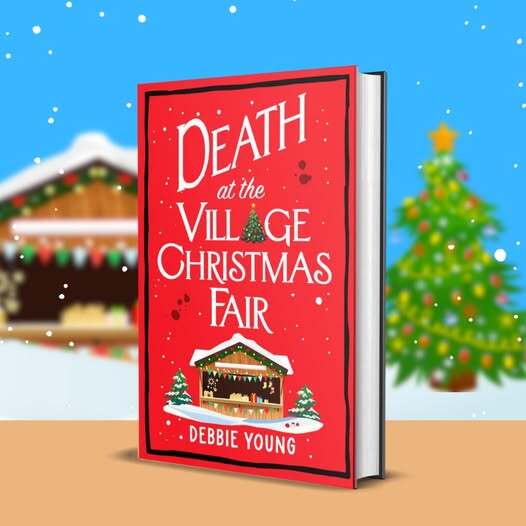 Out now!
Out now! Meanwhile I’m gearing up for the Hawkesbury Village Show this coming Saturday – the traditional horticultural show that inspired my very first novel, Best Murder in Show, all those years ago!
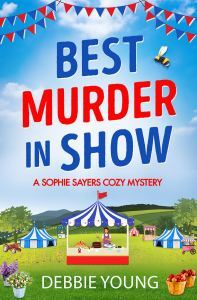 My first ever novel was inspired by the Hawkesbury Show
My first ever novel was inspired by the Hawkesbury ShowIf you happen to be within easy reach of Hawkesbury Upton, do come along to join me at Hawkesbury Show on Saturday 30th August, when I’ll be manning the Hawkesbury Upton Literature Festival‘s stand, promoting the next HULF event on Saturday 27th September – a fun day of talks, discussions and readings with 12 guest speakers, on the theme of “Strength of Character”. This event will mark the 10th birthday of the village literary festival that I founded ten years ago.
 Just some of the many books that will be discussed at our 10th Birthday Special event on 27th September
Just some of the many books that will be discussed at our 10th Birthday Special event on 27th SeptemberAlso on the stand will be fellow authors Lucienne Boyce, Frances Evesham, Sarah Sian Chave, Betty Salthouse, Jack Chandler and Stefania Hartley – all of whom will also be speaking at HULF in September! More details of the September event and tickets are available via Eventbrite here: https://HULF10.eventbrite.co.uk.
Then on the Sunday morning, in the Show marquee, by then empty of all its exhibits, I’ll be speaking at our traditional Songs of Praise service, in which six hymns are chosen by members of the parish – only in this case, they will be from our fellow parishes within the Badminton Benefice, as it’s the fifth Sunday of the month, when all the parishes, who share the same vicar, the Rev Richard Thomson, also share a single service.

 A Little Learning: The First Volume of an Autobiography by Evelyn Waugh
A Little Learning: The First Volume of an Autobiography by Evelyn Waugh
Evelyn Waugh is one of my favourite authors, so I am keen to read everything he has written, and only discovered this recently. particularly interesting to see the influence of his own formative years over his novels Decline and Fall and Brideshead Revisited, and always a joy to read his measured prose.
Having finished reading this book while I was in Norfolk, I downloaded the audiobook of Brideshead Revisited, narrated by Jeremy Irons, for the long drive home. The perfect travelling companion!
But now I must dash – I’m off to ring the bells at our parish church of St Mary’s Hawkesbury. No, I don’t know how I fit it all in either…
August 18, 2025
Music to my Ears
This week’s post is literally about music – but another kind of music to my ears is readers’ early reactions to my new novel, launched last Saturday, and now available in ebook, paperback, hardback and audiobook.
Death at the Village Christmas Fair is the third in the Cotswold Curiosity Shop cosy mystery series, a festive edition launching in midsummer, because that’s the way the publishing industry works – operating a season ahead of reality, just like the fashion industry!
I’m delighted by how many readers are already getting stuck into this story when the weather in the northern hemisphere, where I am, is far from wintry! Some readers have told me they prefer reading wintry books in hot weather to cool them down. So maybe Death at the Village Christmas Fair, with its snowy cover, is really the perfect beach read
Here’s the blurb for the book to whet your appetite:
It’s been a busy year for Alice Carroll, with her Curiosity Shop opening for business, and not one but two murders shaking things up in her quaint Cotswold village. She’s looking forward to her first countryside Christmas, complete with traditional Christmas Fair and Santa Run.
But her hopes for innocent festive fun are thwarted when one of the Santa Runners steals something from her mum’s knitting stall. His festive outfit makes him hard to spot, until he’s found fatally injured outside the village hall with the stolen item.
Despite what the police say, Alice suspects there’s more to his murder than meets the eye. She’s determined to solve the mystery – including why, once more, a stranger thought something from her Curiosity Shop was worth killing for.
With the help of her charming neighbour Robert Praed, can Alice find the killer before the bells ring out this Christmas?
Perfect for fans of Fiona Leitch, Faith Martin and Agatha Christie.
Here is what early reviewers have said about it so far:
‘A nice easily enjoyable cosy crime story with a smashing ending’ – Alyson Reads‘A cosy mystery full of mystery and intrigue, and is my favourite of the series’ – StaceyWH100‘A brilliant page-turner readers will devour in a single sitting’ – Bookish JottingsTo order your copy online now, click here.
Now onto a different kind of music to my ears: Caroline Sanderson’s new memoir, Listen with Father: How I Learned to Love Classical Music…
For the Love of MusicThe photo of the vintage reel-to-reel tape recorder on the cover of Caroline Sanderson’s new memoir, Listen with Father, made me realise how much our access to recorded music has changed during my lifetime.
My first memory of listening to records is via a wind-up record player when I was three years old. I’m not as ancient as that suggests, but the previous owner of the house we moved into had left it behind, and my brother and sister and I were allowed to treat it as a toy.
Then came a reel-to-reel tape player, like the one on Caroline’s book, followed by a fancy radiogram, housing an analogue radio and a turntable in a classic mid-century design, its wide, low cabinet on spindly legs. Its turntable had three speeds: 33rpm for LPs (long-playing records), 45rpm for singles, and 78rpm for any discs left over from the days of wind-up gramophones.
Not long after I started secondary school, compact cassette players were on my friends’ Christmas wish lists. Others favoured 8-track cartridge players, with the figure-of-eight set-up of the tape allowing non-stop music.
By the end of the Seventies, many music buffs aspired to a sleek stacking hi-fi system, with separate layers for records, cassettes and radio tuners. My university friend Tim was proud of his shiny new hi-fi until his confession that he had only two records, one of which was Supertramp, cued merciless teasing.
My stereo at this time was much more modest – a tiny turntable and diminutive speakers encased in bright orange plastic. Well, it was the Seventies.
By the time I was earning my living, the Sony Walkman, first for cassettes, then with newfangled CDs, was every commuter’s must-have accessory. These compact devices look huge and unwieldy compared to their successor: the tiny, lightweight iPods with no moving parts.
Now that we all stream music on our smartphones and smart speakers—and in my husband’s case, to his hearing aids – our family’s old iPods, in seaside-rock pink and vivid lime green, look like museum pieces.
Whatever next? Tiny receiver chips embedded in our heads? Douglas Adams’ Babel fish—a live fish dropped into the ear to act as an instant translator—seems less fantastical now than when it first appeared in The Hitchhiker’s’ Guide to the Galaxy, published in 1978 (the year I bought my orange stereo).
While afficionados argue the case for which recording format produces the better listening experience, to my mind none of them beats hearing music live.
Although a live performance lacks studio edits and polish, no recording can reproduce the excitement of watching a musician physically present, complete with body language, facial expressions, and emotions.
That’s one reason why it’s been such a joy to attend this summer’s Badminton Benefice Music Festival events – three down…
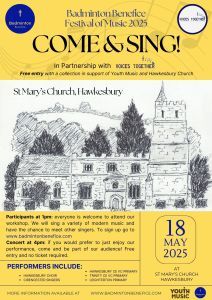

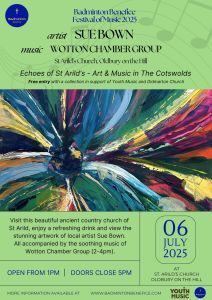
two still to come…
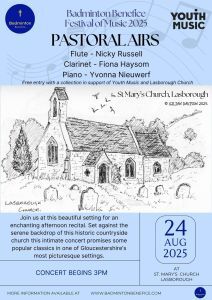
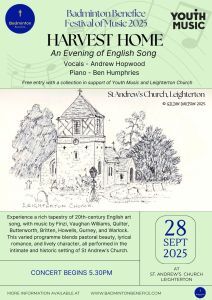
The immediacy adds an extra dimension, as does the glorious setting of our ancient Cotswold parish churches.
Plus, the concerts are free to attend, with free parking and complimentary refreshments, so no-one is priced out of the pleasure.
That includes families with children or grandchildren. The concerts provide the perfect way to enthuse young people about live music. They may even encourage them to take up an instrument or singing lessons themselves—or to do more practice, if they’re already learning. In an age where young people’s opportunities to learn and play music are diminishing, we’re lucky to have access to so many live, free music events on our home turf.
So, let’s turn off the tech for what’s left of the summer, and enjoy the original source of all music: the human being, in real life, in real time.
(This article first appeared in the August 2025 edition of the Hawkesbury Parish News.)
WHAT I’VE READ THIS WEEK
As you may know, I’m a course tutor for Jericho Writers. and I try to read as many of my students books as possible. This one was a real treat-to-self – and the first in Kalyn’s series was a great read too.
 For the Love of Mark Twain: A Cozy Academia Friends-to-Lovers Story by Kalyn Gensic
For the Love of Mark Twain: A Cozy Academia Friends-to-Lovers Story by Kalyn Gensic
My rating: 4 of 5 stars
What a great read for back-to-school time! I very much enjoyed reading this gentle, slow-burn romance between likeable characters on the staff of a small American university, a setting I wasn’t familiar with, so that added extra interest and enjoyment for me. Well written, witty, and engaging, with a cast of well-drawn and endearing supporting characters, this is a cosy read to linger over and make it last. Highly recommended.
August 11, 2025
Don’t Blame the Borrowers
In today’s new blog post, I’m sharing my latest column for the Tetbury Advertiser, plus a sneak preview of my new novel, Death at the Christmas Village Fair, which launches on 16th August, and reviews of recent holiday reads.
Tidying the mug shelf in my walk-in larder, I’m mourning the fact that only my favourite mugs ever get broken. I’m down to a single bone-china Cath Kidston, surrounded by numerous unwanted chunky ones. Similarly, I only ever seem to lose my best earrings.
Of course, that’s because they’re the ones I use the most. I must face facts and stop blaming the Borrowers – those tiny folk that live behind the wainscotting, stealing our things while we’re not looking, according to children’s author Mary Norton. Even so, I’m convinced some live in my house.
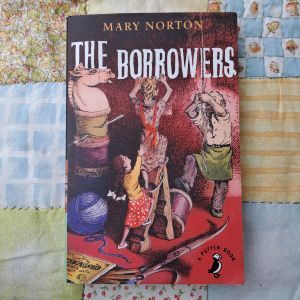 If you haven’t read “The Borrowers” by Mary Norton, you’re in for a treat
If you haven’t read “The Borrowers” by Mary Norton, you’re in for a treatThere’s a simple solution. If I use the chunky mugs more often and wear my least-loved earrings more frequently, my best of both are more likely to survive long term.
To be on the safe side, I might stop using them altogether. I already take off my earrings on bell ringing practice nights, since losing a favourite filigree silver heart there. Fortunately, a fellow ringer found it the following week and enquired whether anyone had lost their heart in the bell tower.
The up-and-down arm motion required for bell ringing is a particular hazard to drop earrings. For similar reasons, we’re not allowed to wear scarves while ringing. An unruly rebound of the rope catching anything tied around your neck could hoist you aloft, with dire consequences. Fortunately, the worst I’ve done is to knock my glasses off with my bell rope, jettisoning out of the ringing chamber to land halfway down the nave.
Witnessing the swift, savage power of the rope close at hand was scary. No wonder my bell ringer chums keep telling me different ways to murder someone in with a bell–as story ideas for my murder mystery novels, I hasten to add, rather than for practical use.
In contrast, I never lose or damage my favourite notebooks. That’s because they never leave the safety of the notebook shelf in my study. I kid myself I’m saving the best ones for special occasions, but in truth I can’t bear to sully their pages.
It’s particularly obtuse not to use them when I write the first drafts of my novels by hand. Using only alternate lines to allow room for correction, and under contract for two to three novels a year, I get through a lot of notebooks.
Am I turning into my maternal grandmother? She used to stash her best things away unused.
We only discovered them after she’d died, including a beautiful bone-china cup and saucer I gave her for her last birthday.
To guard against the same thing happening with my notebooks, I must force myself to use them. I know I’ll enjoy writing in them. I just need to designate suitably worthy projects. Drafting my columns for the Tetbury Advertiser, perhaps? That’s one way to encourage me to meet its copy deadlines.
(With thanks to the TA’s editor Mary for her endless patience!)
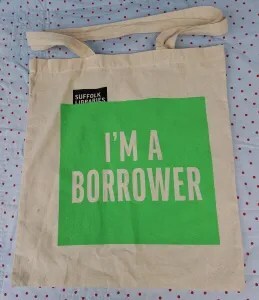 Last word to The Borrowers: I spotted this book bag in Glemsfort Public Library while visiting my aunt, and even though I have a huge quantity of tote bags at home, none of which ever go missing, I couldn’t resist.In Other News
Last word to The Borrowers: I spotted this book bag in Glemsfort Public Library while visiting my aunt, and even though I have a huge quantity of tote bags at home, none of which ever go missing, I couldn’t resist.In Other NewsI’m counting down the days to the launch of my next cosy mystery novel – and at the time of posting this blog, the fingers of one hand are sufficient…
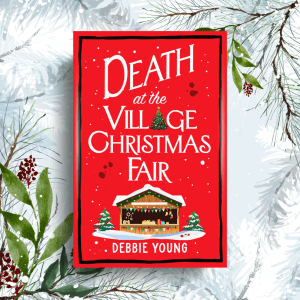 To be published on Saturday 16th August
To be published on Saturday 16th AugustDeath at the Village Christmas Fair will be published on Saturday 16th August – in plenty of time for the festive season! In this third Cotswold Curiosity Shop story, Alice Carroll is looking forward to her first traditional village Christmas. Each novel in this series is triggered by an object in Alice’s bric-a-brac shop, and this time it’s the turn of a button box – but quite why her collection of buttons is causing havoc across the village, she is unsure. When a missing button is dismissed as a clue to a murder, Alice thinks differently – and soon she’s on the case, withe the aid of her mum, avid knitter Wendy, her wealthy neighbour Robert, and her lodger Danny. Not to mention the vicar’s wife, whose behaviour is distinctly suspicious…
Pre-order your copy on Amazon’s UK store here, from Amazon US here, or at your local bookshop. Also available at many other stores worldwide, in ebook, paperback, hardback, and audiobook.
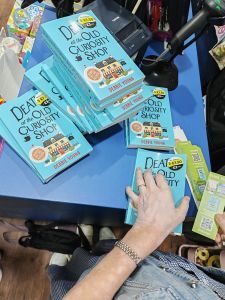 Meanwhile I’ve been signing more copies of the first in this series, Death at the Old Curiosity Shop, at The Works in Newport and Gloucester – all fabulous shops with such friendly, helpful staff who are clearly much loved by their customers. You might also spot copies of this book in selected garden centres, thanks to a brilliant deal my publisher has done with these stores. Not forgetting it’s also now available in the latest catalogue of PostScript, the online retailer of discounted paperback books!
Meanwhile I’ve been signing more copies of the first in this series, Death at the Old Curiosity Shop, at The Works in Newport and Gloucester – all fabulous shops with such friendly, helpful staff who are clearly much loved by their customers. You might also spot copies of this book in selected garden centres, thanks to a brilliant deal my publisher has done with these stores. Not forgetting it’s also now available in the latest catalogue of PostScript, the online retailer of discounted paperback books!
I’ll be telling you more about The Works and how they operate in a future post here.
In between times, I’m working hard on a new standalone novel, The Importance of Being Murdered, and have just hit the halfway mark in terms of word count. I’m writing each chapter from a different viewpoint – something I did for the first time in my latest Sophie Sayers story (see below), and which I really enjoyed doing. As I’m used to writing in the first person of one character only, I thought it might be tricky, but it’s come more easily than I’d expected.
Fingers crossed that my editor likes it too – and my readers, when it eventually reaches them!
Plus, I’m getting ready for the next Hawkesbury Upton Literature Festival event on Saturday 27th September, on the theme of “Strength of Character”. It’ll be a fun, quickfire day of talks and readings by a brilliant line-up of local authors plus one artist, James Nickells, whose portraits tell amazing stories. To find out more about it, head over to the Festival website at www.hulitfest.com, where you can also find the buying link to book your ticket now.

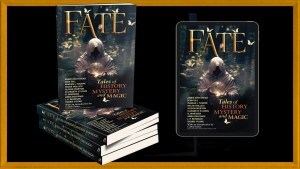 And finally, if you’d like to sample the opening of my new Sophie Sayers short story, “Saints Alive”, which was published recently in the anthology Fate: Tales of History, Mystery & Magic, edited by Helen Hollick, you can do so on fellow contributor Elizabeth St John’s website, where she shared the opening page of all ten stories.
And finally, if you’d like to sample the opening of my new Sophie Sayers short story, “Saints Alive”, which was published recently in the anthology Fate: Tales of History, Mystery & Magic, edited by Helen Hollick, you can do so on fellow contributor Elizabeth St John’s website, where she shared the opening page of all ten stories.
Read the opening of “Saints Alive” here
What I Read This Week (via Goodreads) Partners in Grime by Jay Larkin
Partners in Grime by Jay Larkin
My rating: 4 of 5 stars
Always a joy to catch up on the latest cases of Aunt Audrey’s Angels, the cleaning company run by amateur sleuth Jenny Brooks. What’s particularly refreshing about this series is that each chapter is a separate crime case – and none of them involve murder. Also, they’re set a few decades ago, so evidence surfaces in the form of good old-fashioned photographs and press cuttings, rather than with online searches and global digital connectivity. A breath of fresh air, providing soothing reading for bedtimes and holidays.
 The Underground City: Set Underneath Loch Katerine. a New Translation of the Complete Text With Illustrations. by Jules Verne
The Underground City: Set Underneath Loch Katerine. a New Translation of the Complete Text With Illustrations. by Jules Verne
My rating: 5 of 5 stars
Cracking traditional adventure story – so pleased to discover it on a trip to Scotland, visiting the very places that inspired Verne to write this book.
This edition is particularly special because it’s published by a local small press in nearby Edinburgh and retains all the original line drawings – so atmospheric. Quite a feat to draw vivid black-and-white pictures of a story when most of it takes place underground in a coal mine!
August 4, 2025
How I Keep Track of What I Read with Goodreads
For many years, my mum has kept a little notebook in which she writes down the titles and authors of books she has read. As the most avid reader I know, she has inspired my to keep track of my own reading, and for the last five years, I’ve done the same in a now rather dog-eared Alice in Wondlerland notebook.
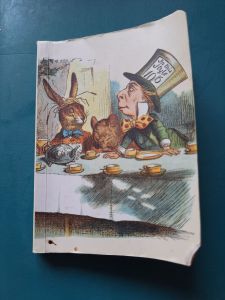
Many years ago, I used also to keep a bookblog, sharing my reviews via blog posts, but when that became too time-consuming, I reviewed books on Amazon instead, and occasionally on Goodreads.
Are you familiar with the app GoodReads? It’s a kind of social media for readers that helps you track your own reading, share what you thought of books via ratings and reviews
Originally, Goodreads felt like a little world of its own, away from retail platforms. As well as sharing book reviews, members could also befriend each other and follow their favourite authors.
For historical reasons that have passed me by, reviewers on Goodreads tend to be more sparing with the stars than on Amazon – even when the same reviewer is pasting exactly the same review for the same book on both platforms! What gains a 4*, for example, on Amazon, generally earns 3* on Goodreads.
This is all the more bizarre now that Amazon owns Goodreads, after buying the previously independent platform a few years ago. It’s now Amazonised it in other ways, eg every book’s profile includes a link to buy it on Amazon. Also, just as Amazon does, it recommends similar books you might like to read next. (So with my author’s hat on, it is a handy source of new readers who discover me via Goodreads’ recommendations!)
There are still some other differences between the two platforms, eg Amazon’s retail store site it strictly policed (if not always consistently) for misdemeanours by publishers, authors, and readers alike, whereas Goodreads still feels a bit like the Wild West, with only designated “librarians” recruited from its membership to resolve users’ queries voluntarily.
It can also be subject to people gaming the system, eg setting up “lists” of the best books in certain categories – and then use them to vote their own or their mates’ books to the top of the list! After all, Jane Austen and her ilk aren’t around to persuade their followers to vote her books to the top of their categories!
For various reasons, I’ve fallen out of the habit of posting on Goodreads, but now I’ve realised that it’s time to retire my tatty reading record notebook and use Goodreads instead to record the books I’ve read.
You can also use it to list books you would like to read, and to track progress as you go, and even to record books you’ve given up on!
Click here to follow me on Goodreads, and you’ll also be kept up-to-date with reviews of the books I write, as well as those I read. Feel free to post your reviews there too!
(I haven’t yet transferred across all the books from my reading record notebook, but plan to when I get an idle moment – or need to procrastinate from my work-in-progress!)
I also thought I’d take advantage of Goodreads’ handy facility to embed each new book review in a blog. So as an experiment, I thought I’d append my reviews of what I read each week to the end of each new blog post. Tell me if it gets too much and I’ll stop!
In the meantime, happy reading, whether or not you share your books on Goodreads!
What I Read This Week (via Goodreads) The Memoirs of Marie: Abbess and Poet by Deborah Jones
The Memoirs of Marie: Abbess and Poet by Deborah Jones
My rating: 5 of 5 stars
Another fascinating imagined insight into the life of one of the early Abbesses of Shaftesbury and the complex relationships between royalty and nobility in England and France (which make 21st century “blended” families look simple!) I confess I wasn’t familiar with Marie de France before – my only knowledge of this period was from the wonderful film “The Lion in Winter”, with Katharine Hepburn playing Eleanor of Aquitaine and Peter O’Toole as Henry II, but am now keen to find out more, and to read more of Marie de France’s writing, hooked by the delightful “tasting menu” at the back of this book.
A shout-out for the cover artist Alison Merry too – the set of the three of the books in the series so far are beautiful to look at on my bookshelf!
I hope there will be more in this compelling series.
 The Cradle And The Cage by Hastie Salih
The Cradle And The Cage by Hastie Salih
My rating: 5 of 5 stars
Wow, what a whirlwind of a story, from which I learned so much about Kurdistan and its many contrasts – from the beautiful cradle of civilization to melting pot of inequalities and injustice – through the gripping story of a young British woman who visits her mother’s homeland on what she hopes will be a pleasant holiday. Meeting members of her family is the starting point for a shocking quest that changes her life forever – and her sense of self, as well as her sense of her past. I felt my understanding of certain political and human rights issues was much enhanced by reading this book – but I’m not saying what they are, for fear of spoiling the plot.
I enjoyed this so much that I’m going to buy the author’s first book now too.
(Special shout-out for the cover designer by the way – perfect for the nature of the book, and looking very striking on my coffee table!)
View all my reviews on Goodreads
In Other News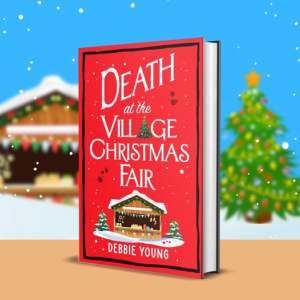 Coming on 16th August! Novel #16, and counting…
Coming on 16th August! Novel #16, and counting…It may still be summer (in the northern hemisphere where I am, anyway!), but it’s less than a fortnight until the launch of the third in my Cotswold Curiosity Shop cosy mystery series, Death at the Village Christmas Fair! It’s now available to pre-order online eg from Amazon UK or from Amazon US, or ask your local bookshop to order the paperback for you quoting the ISBN 978-1835185827 (the publisher is Boldwood Books).
Now back to writing my work-in-progress, a new standalone cosy mystery novel based on my play script, The Importance of Being Murdered…
July 28, 2025
In Conversation with Alison Morton
At the end of each month, I invite an author friend to join me in conversation about their latest book or other project of mutual interest. I hope this occasional series gives you interesting insights into what goes on behind the scenes in our writing world, and how authors work.
July’s guest is Alison Morton. Although we’re writing in very different genres – Alison writes contemporary and alternative history thrillers and I write cosy mystery – we share a love of penning series. What prompted today’s conversation is the recent launch of the third in her “Doubles” series of contemporary thrillers, Double Stakes.
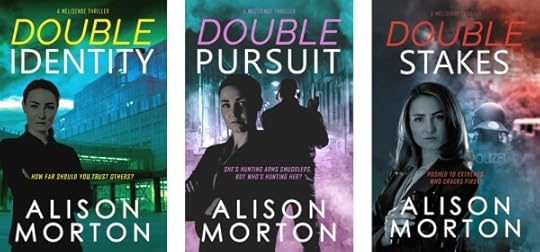 The story so far…
The story so far…Debbie: Your latest novel, Double Stakes, is the third in a trilogy that began with Double Identity and Double Pursuit. A trilogy is often thought by the world of traditional publishers to be a golden ticket in marketing terms, because of sell-through or read-through – i.e. a reader hooked by the first in series is likely to snap up books 2 and 3 without much persuasion. It’s far easier to sell the second and third books in a trilogy to a satisfied reader of book 1 than a new stand-alone or first-in-series.
But you and I have both gone beyond that magic number with our other series – your vast Roma Nova series and my Sophie Sayers cosy mysteries (nine books and many associated short fiction pieces) and St Bride’s school series (four of a planned six books published so far).
We’re in the very good company of Douglas Adams, who described his Hitchhiker’s Guide to the Galaxy series as “a trilogy in five parts”!
Will Mélisende’s trilogy stop at three books, or is she set to return?
Alison: Yes, Roma Nova grew and grew and now comprises eleven books. New ones would be spin-offs via other historical periods or following other characters’ adventures. The Doubles are open-ended. Mel is about to celebrate her thirtieth birthday but I can see several more missions before she hangs up her holster.
Debbie: An aside on naming conventions: when I licensed my St Bride’s series to Boldwood Books, which I’d begun with the simply-named Secrets at St Bride’s and Stranger at St Bride’s, they devised a new, more complex and commercial pattern for their titles, so now the four books so far are called Dastardly Deeds at St Bride’s, Sinister Stranger at St Bride’s, Wicked Whispers at St Bride’s, and Artful Antics at St Bride’s. Coming up with titles for the planned books 5 and 6 will thus require a pair of alliterative words that set the tone for each adventure – not easy!
You’ve had interesting – and challenging – naming conventions for each of your series. Tell us a bit about your Latin titles for the Roma Nova books, and the “Double” style for Mélisende’s adventures.
Alison: Ha! For the Roma Nova novels, I wanted Latin or Latin sounding names, preferably one-word, that would give the non-Latin speaker an idea about the story. INCEPTIO means the beginning – perfect for the first in the series and the start of Carina’s own life in Roma Nova. PERFIDITAS is made up, building on perfidia mean faithlessness or betrayal but there’s a famous song and a number of books called Perfidia. Adding ‘-as’ conveys a state of being such as romanitas means Roman-ness. SUCCESSIO doesn’t mean success! It’s more like succession which carries twin meanings of ‘what happened next’ and ‘the next generation’. Nothing to do with any TV series!
INSURRECTIO and RETALIO are pretty much self-explanatory as is EXSILIUM. I broke my one-word rule for JULIA PRIMA as there are so many books with ‘Julia’ as their title and my Julia was the first or prime ancestor of Roma Nova’s ruling family.
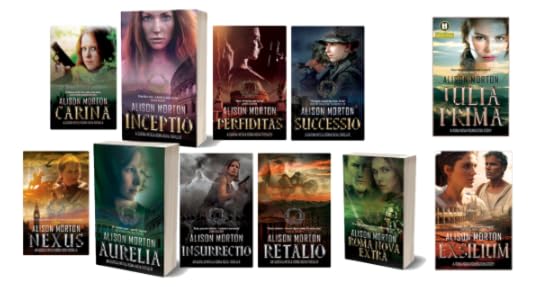 Fun fact: the titles are in upper case because in ancient Latin script there are only capital letters!
Fun fact: the titles are in upper case because in ancient Latin script there are only capital letters!As for the Doubles… Double Identity was a play on the famous thriller movie Double Indemnity. Also, the heroine has a split heritage and is never completely sure which one she belongs to. For Double Pursuit, I reckoned I had half the title in the first word! More realistically, she’s pursuing the bad guys, but somebody is pursuing her… Now I’d set the pattern, the following book had to be Double Something! The stakes are high as in any thriller, but the word also refers to gambling as well as political stakes.
Debbie: In between writing our novels, we share a love of penning short stories to stretch our writing muscles in a different way, and perhaps also as palate cleansers. But how we came to write them differs. I’ve always loved writing short stories and took a bit of self-persuasion to tackle the larger canvas of the novel (no holding me now, though!) Whereas at one time, you had to be dragged kicking and screaming to the shorter form but now are a frequent contributor to short story anthologies.
These are a great way for any author to broaden their reach, and the camaraderie involved in their production is fun too. We each have written very different tales responding to the brief of the new anthology Fate: Tales of History, Mystery and Magic, edited by our mutual friend Helen Hollick. I loved the premise (and execution) of your contribution. Can you please whet readers appetites by briefly describing it?
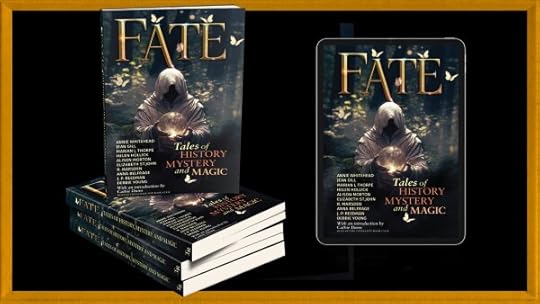 Click image to preview on Amazon
Click image to preview on AmazonAlison: Helen instructed us to go wild, so I did, but I can’t leave Rome out of any of my stories! The assassination of G. Julius Caesar is one of those iconic events in history, but suppose it hadn’t happened? What would be the consequences if it hadn’t? But would the Fates allow Caesar to be saved? Two young time-travellers are sent back from the alternative future to fix the problem. However, they keep getting sidelined or tripping over their togas. But the Fates, the Roman Parcae, are watching and they will not be mocked!
Debbie: Now I’m back to writing my next novel. What are you writing now?
Alison: I decided it was time to revisit Roma Nova, so I’ve started a new story featuring Carina, the heroine of the first four Roma Nova stories. I’m not a planner so I just plunge and discover how the story unfolds as I write it. At present it’s just over 5,000 words and I’m looking forward to seeing where it takes me.
Debbie: I look forward to finding out what Carina gets up to next!
Regarding WIPs (work-in-progress), I like to keep a talisman on my desk relevant to my current writing project. For my new novel, Death at the Village Christmas Fair, to be published by Boldwood Books on 16th August, my lucky charm was a small wooden bear, a replica of a Japanese netsuke. (The reasons will become clear when you read the book!) Do you keep any such tokens on your writing desk, or do you have any other writing superstitions of any kind?
Re broader superstitions, by the way, Lee Child’s famous conviction that he should start each new novel on 1st September each year didn’t do him any harm!
Alison: No – but I do make sure I have a cup of tea by my desk all the time!
Debbie: Some say we should write what we know. In my books I draw extensively on over three decades of living in a Cotswold village plus 13 years of working in a girls’ rural boarding school. What aspects of your real life inform your books?
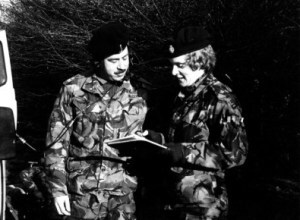 Alison: Well, apart from being a voracious reader of thrillers and historical fiction from a very young age, I served six years in a special communications regiment in the Royal Signals, so saw military life from the inside. The other strong influence is the Roman one. I’ve clambered over most of Roman Europe by now and I’m mesmerised by the whole 1200 years of it. There’s nothing comparable to running your hand over a section of 2,000-year-old Roman concrete…
Alison: Well, apart from being a voracious reader of thrillers and historical fiction from a very young age, I served six years in a special communications regiment in the Royal Signals, so saw military life from the inside. The other strong influence is the Roman one. I’ve clambered over most of Roman Europe by now and I’m mesmerised by the whole 1200 years of it. There’s nothing comparable to running your hand over a section of 2,000-year-old Roman concrete…
 Roman concrete and brickwork
Roman concrete and brickworkDebbie: A not unrelated question: as a long-time British resident of France recently awarded French citizenship, to what extend do your dual allegiances drive the characters and themes of your novels?
Alison: The main difference is the mindset. French and British people roughly share the same Western values and ideas, so there’s a lot in common. French people are more formal in many ways and pride themselves on their professionalism. They’re also more polite! Woe to you if you fail to utter even a minimal bonjour when you enter a shop or office. They also tend to discuss round a subject thoroughly before reaching a conclusion, something that tend to make Brits impatient!
Lunch is very important, although the ‘sandwich at the desk’ is becoming more common in French cities at midday. Very sad.
In the Doubles thrillers, Mel seems at home in both environments, more so than her brother Arnaud. She serves in the French Army, but uses her English skills extensively. And she is familiar with French bureaucracy (which isn’t as bad as it’s reputed to be), but loves shopping at Marks & Spencer and Clarks when in the UK.
 Alison was keen on the Romans from a very early age
Alison was keen on the Romans from a very early ageDebbie: The philosopher Hegel said, “The only thing that we learn from history is that we learn nothing from history.” What can we learn from alternative history, and indeed from your Doubles series, which is contemporary fiction, that we do not learn from actual history?
Alison: Alternative history allows us a rich environment in which to develop our storytelling and let our imaginations soar in a historical and futuristic framework. Like all speculative fiction and a fair bit of historical fiction, ‘althist’ may well reflect concerns of the time when it’s written.
But above all it allows us to explore unthinkable, frightening or utopian worlds from the safety of our favourite reading chair.
The Doubles, firmly fixed in the present, have enabled me to look at contemporary issues which have a historical origin. I couldn’t help setting a chase in Trajan’s Market in Rome in Double Pursuit. It’s a spectacular and evocative building that’s survived two millennia! What does that say about history?
And Mel takes the side of the Celtic tribes when discussing the Romans with colleague Andreas. These are side conversations, but allow a divergence from the norm. Double Stakes goes into grimmer territory of the rise of the far right in Europe. This is brimming with historical echoes and we do well to consider their consequences in thinking back to the 1930s.
Debbie: Alison, finally could you please share a brief introduction to your latest novel and its place in your Doubles trilogy, with a single buying link for anyone wishing to find out more.
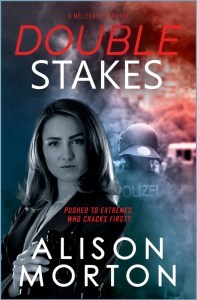 A kidnapped daughter. A rigged election. A family under siege.
A kidnapped daughter. A rigged election. A family under siege.
Former French special forces intelligence analyst Mélisende is desperate for recovery time after a gruelling mission. But when enforcers attack her family home in rural France, she uncovers a shocking truth – her sister-in-law’s gambling debt has put them all in danger.
Before Mel can untangle the crisis, she is ordered to Germany, where the daughter of Achim Nessler – the front-runner for chancellor – has been abducted. The kidnappers’ goal? To force Nessler to throw the upcoming election, paving the way for a hard-right victory that could upend not just Germany, but all of Europe.
Racing against time, Mel and fellow investigator Jeff McCracken dive into the murky world of extremist politics where old wounds and new betrayals collide. But as their hunt leads them deep into eastern Germany’s shadows, Mel discovers a chilling link between the case and her own family’s troubles.
Now, with both a nation’s future and her loved ones at stake, Mel must risk everything to stop a conspiracy that hits closer to home than she ever imagined
What readers are saying about Double Stakes:
“The plot is complex and fast moving; and the political and geographical details are fascinating. This is a compelling thriller, a page turner, which I thoroughly recommend.” – Mystery People
“Mélisende is once again at the top of her game and with Jeff by her side, they are unstoppable.” – Avonna Loves Genres
About Alison MortonFind out more about Alison Morton and her books at her website, www.alison-morton.com, which includes links to her social media.
Sign up for her newsletter to receive two free stories:
The Sand Beneath her Feet, the prequel to the Doubles series and Mel’s last mission before leaving the French Army. Of course, it doesn’t go smoothly.Conrad & Carina’s Roman Holiday, in which two 21st century Praetorians delve into an ancient Roman mystery.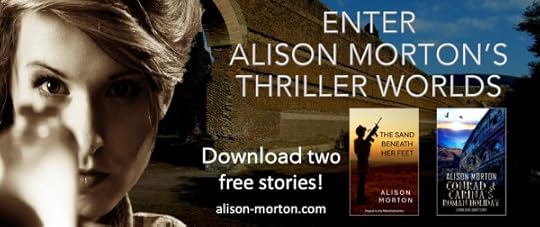 Click image to subscribe to Alison’s free newsletter now and receive these two free stories
Click image to subscribe to Alison’s free newsletter now and receive these two free stories
July 14, 2025
Not the Retiring Kind
On discovering the upper recruitment age for the British Armed Forces is 39, I feel a flash of FOMO (Fear of Missing Out). I’ve missed that boat–or tank, or fighter jet–by a couple of decades. The same goes for the police force. Although there’s no age limit for joining up, they expect you to retire by 60.
I don’t know why this irks me. Despite my father having served in the Royal Navy, I never wanted to join any of the Forces. Even as a child, I knew I wanted to be when I grew up: a writer.
Tick! My sixteenth novel, Death at the Village Christmas Fair, will be published on 16th August.
Next up: novel #16, the third in my Cotswold Curiosity Shop series
Although I came to writing by a roundabout route, via journalism, PR and charity work, I got there in the end. I know in my heart I’ll never want to do anything else. Nor will I ever retire. I’ll be writing until I drop.
And yet, I feel a pang of envy when I see adverts full of the promise of different career paths, and not only those for the Forces. How wonderful to change young lives by retraining as a teacher, I muse, at least for the duration of the commercial.* Oh, to be starting out, with all to play for.
To snap out of such daydreams, I have only to remember what I hated about my past ‘proper’ jobs:
9-to-5 working days that don’t suit my night-owl natureA wrap-around lengthy commute – two hours each way was once normal for meInterminable serious meetings when I wanted to make people laughSunday evenings spoiled by the countdown to MondayThe constraints of office dress, especially stifling suitsDreary packed lunches and shop-bought sandwiches (my one job in a school whose staff perks included hearty school dinners was a joyful reprieve)However, if I ever change my mind about this writing lark, one employment avenue will remain open to me, now and into my dotage, provided I first learn a little about DIY. Perhaps I could pick it up by osmosis from my handyman husband. Then I could apply to B&Q. Justly proud of its anti-ageist employment policy, the DIY chain practises what it preaches. Its oldest employee on record stood down when he was 96. I wonder what they gave him as a retirement present.
(This post first appeared in the Hawkesbury Parish News July 2025 edition.)
*Although I don’t think of myself as a teacher, for the last few years I’ve been a course tutor for Jericho Writers, leading my Simply Self Publish course online, which next runs from October to December. Click here if you’re interested in self-publishing and would like to know more.
IN OTHER NEWSLife has been so busy that I’ve been struggling to keep up with my supposedly weekly blog and monthly newsletter. I’m hoping to get back on track this month, so please bear with me! The interval between finishing the edits of Death at the Village Christmas Fair and agreeing with my publisher which book to write next has allowed me to catch up slightly. In anticipation of a fresh start, I’ve just bought a new academic year diary, which starts on 1st August, along with my resolutions to do better!
If you’ve not yet joined my Readers’ Club, click here to join now (it’s free, and you can unsubscribe any time). Then I’ll send you the link to download a free ebook novelette, The Pride of Peacocks, as well as sending you future issues of my newsletter.
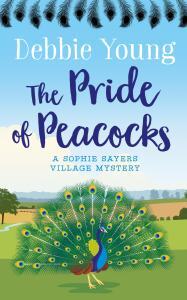 An ebook of this Sophie Sayers novelette is my gift to you when you join my free Freaders’ ClubWhat’s Next?
An ebook of this Sophie Sayers novelette is my gift to you when you join my free Freaders’ ClubWhat’s Next?So what will my next book be, I hear you cry? I’m excited to tell you that it will be the novelisation of my first stage play, The Importance of Being Murdered, which I wrote for the Hawkesbury Drama Group to perform last April. The company brought it brilliantly to life, and as I adapt it to novel form, it is their actors that I will be picturing in my head! They’ve also asked me to write another murder mystery for them for next April, so you never know, this could turn out to be the start of a new series of novels …
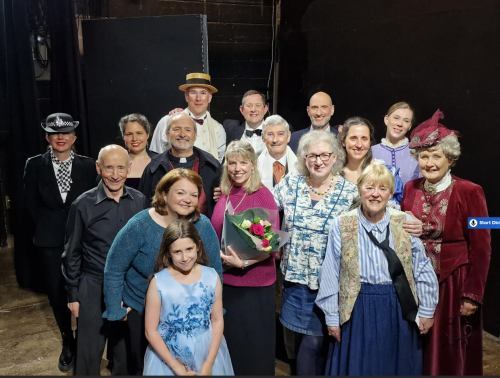 After-show photo of the brilliant cast of the first production of “The Importance of Being Murdered” – with me in the blue and white top, centre (Photo by Bill Fairney, who played Bertram Manchester – in white silk scarf, to my right)
After-show photo of the brilliant cast of the first production of “The Importance of Being Murdered” – with me in the blue and white top, centre (Photo by Bill Fairney, who played Bertram Manchester – in white silk scarf, to my right)The Importance of Being Murdered (my working title, which I hope my publisher will keep) is about a village amateur dramatic company whose production of Oscar Wilde’s The Importance of Being Earnest is disrupted when a retired star of stage and screen moves into the local manor house, demanding a leading role, despite being twice the age of the character he plans to portray.
To complete the transformation from playscript to novel, I’ll need to add a few scenes and other fun bits and pieces such the director’s diary entries, but I’m pleased to say I’m already up to 12k words against a target of 60k.
To keep me in the theatrical zone, I’m reading books by the late great Sir John Gielgud (1904-2000), including his memoir Early Stages which focuses on his live theatre work, and his collected letters. His extraordinary career extended from London’s West End through silent movies (yes, he flourished even before the talkies – his first film credit is 1924!) to BBC drama classics such as Brideshead Revisited, and from British film modern classics such as Chariots of Fire and The Shooting Party to blockbuster films such as Arthur and Gandhi. (Now there’s two films I never expected to put in the same phrase!)
 A sultry young John Gielgud in 1936, a year in which he was playing Hamlet to great acclaim on both sides of the Atlantic (Public domain via Wikimedia Commons)
A sultry young John Gielgud in 1936, a year in which he was playing Hamlet to great acclaim on both sides of the Atlantic (Public domain via Wikimedia Commons) I should say, though, that my character, Bertram Manchester, is not in the same league as the wonderful John Gielgud – even though he thinks he is!
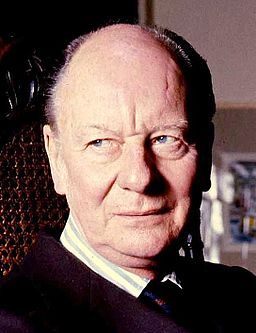 The inimitable John Gielgud as I picture him, relatively late in his career (1973), via Wikimedia Commons
The inimitable John Gielgud as I picture him, relatively late in his career (1973), via Wikimedia CommonsYou can enjoy The Importance of Being Murdered even if you’ve never seen or read The Importance of Being Earnest – but there are some excellent productions available if you’d like to visit or revist Oscar Wilde’s masterpiece, including, I’ve just discovered, an 1951 radio recording starring Gielgud as John Worthing and Dame Edith Evans as Lady Bracknell. Listen to it on YouTube here: https://youtu.be/e4nmuJbuBpc?si=93zIeV5h7RjIb3qi
Other favourite versions are:
1952 film with Dame Edith Evans reprising her role, the delectable Joan Greenwood as Gwendolen Fairfax, and the ever-lovable Margaret Rutherford as Miss Prism (but no John Gielgud!)2002 film with Colin Firth and Rupert Everett having tremendous fun as John and Algernonthe National Theatre’s energetic, camped-up 2025 production now transferring to the Nöel Coward TheatreA QUESTION FOR YOUFinally, I have a question for you. For the last 15 years, I’ve been writing monthly columns for two local magazines, the Hawkesbury Parish News and the Tetbury Advertiser, who kindly allow me to riff on whatever I like each month, usually related to village life and/or to my writing. Originally, I turned each column into blog posts, but more recently I’ve been adding an ever-growing postscript, “In Other News“, about my writing life, in more detail and with greater frequency than it would be possible to fit into my (theoretically) monthly newsletter.
Should I continue this practice OR would you rather hear only about my writing life, journal style as I’ve been doing in In Other News OR should I flip the order of my posts, and lead on the latest news about my writing life, and treat the magazine columns as postscripts?
Ok, that’s actually three questions!
I’d love to know your preference, so please message me your thoughts, or leave a comment below. I’m always glad to hear from my readers via the comments section or via the contact page on my website.
With huge thanks to all of you for your continuing support,
And my very best wishes

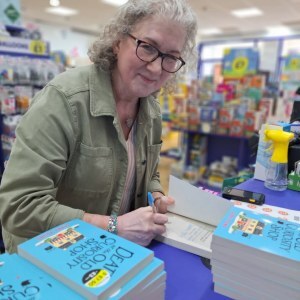 Signing copies of “Death at the Old Curiosity Shop” recently – more about that next time!
Signing copies of “Death at the Old Curiosity Shop” recently – more about that next time!

